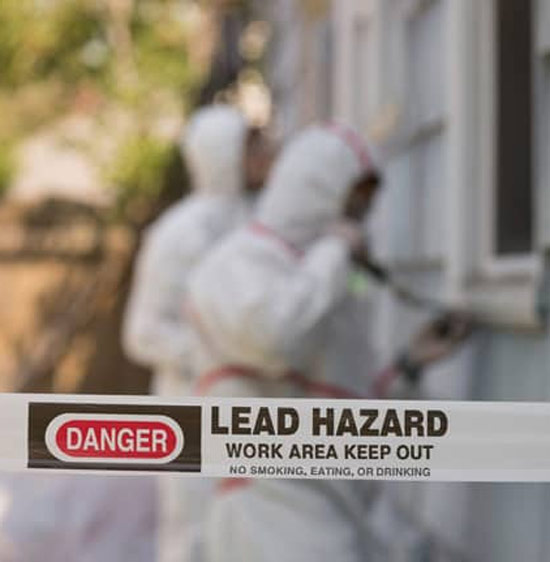NYC Lead Paint Removal Company-- Ensuring Safe and Lawful Conformity
NYC Lead Paint Removal Company-- Ensuring Safe and Lawful Conformity
Blog Article
Step-by-Step Process for Effective Lead Violation Remediation
Following this, adherence to federal and state regulations is critical to developing an effective removal strategy. The real remediation needs proficient employees to execute these plans while purely adhering to safety and security procedures. What occurs after the remediation is completed?

Discovery and Evaluation
Detection and analysis are important actions in the remediation of lead violations. To make certain a reliable removal procedure, it is important to conduct a complete examination of the environment where potential lead exposure exists.
This includes assessing the level and seriousness of contamination, as well as recognizing populaces at threat, particularly youngsters and pregnant women. The gathered information need to be carefully recorded to sustain the development of a reliable remediation method.
Furthermore, it is essential to prioritize locations with the highest possible levels of contamination and those that pose the best health threats. Efficient interaction with stakeholders, including homeowner, citizens, and public health and wellness authorities, is important for ensuring that all events are educated regarding the findings and the succeeding steps needed for removal. This first discovery and evaluation phase lays the foundation for an effective lead violation removal procedure.

Legal and Regulatory Conformity
Navigating the landscape of lawful and regulative compliance is a critical aspect of effective lead violation remediation. Conformity ensures not just the safety of afflicted populations but likewise the reliability and lawful standing of the company in charge of remediation. Laws governing lead contamination are complex, incorporating federal, state, and local regulations. At the government degree, the Epa (EPA) establishes stringent standards under the Poisonous Substances Control Act (TSCA) and the Lead-Based Paint Remodelling, Repair, and Painting Guideline (RRP Policy)
State and regional regulations can vary, often enforcing extra commitments or more stringent criteria. Consequently, a detailed understanding of all relevant lawful frameworks is important. This includes thorough documents of all removal activities to show compliance. Failure to stick to these policies can lead to severe fines, consisting of substantial fines, lawsuit, and reputational damages.
Engaging lawful specialists specialized in ecological law can promote browsing these intricacies. Routine training and qualification for all employees involved in the removal process are likewise mandatory to ensure adherence to security and regulatory requirements. By prioritizing lawful and governing conformity, organizations can efficiently alleviate risks and attain a successful removal outcome.
Preparation the Remediation
Effectively preparing the remediation of lead offenses starts with a complete evaluation of the contaminated website. This first evaluation needs to include a thorough website investigation to determine the level and concentration of lead contamination. Comprehensive tasting and research laboratory analysis are extremely important to create an accurate contamination account. This data-driven method ensures that removal initiatives are properly targeted and efficient.
When the contamination is mapped, a risk assessment should be carried out to examine possible health and wellness threats to humans and the environment. Lead Violation Removal in NYC. This analysis must think about aspects such as exposure pathways, population vulnerability, and eco-friendly effects. The understandings gathered will certainly form the basis for selecting an ideal removal strategy
Consequently, setting clear, achievable goals for the remediation project is critical. These purposes ought to align with regulative criteria and stakeholder assumptions to make sure conformity and neighborhood approval. Creating a detailed remediation strategy that describes approaches, timelines, and source allowance will help with an organized strategy to the cleanup process.
Furthermore, it is vital to engage with stakeholders early and keep clear communication throughout the preparation phase. This consists of informing local communities, getting necessary licenses, and coordinating with regulatory companies to make sure all lawful and step-by-step needs are met. A well-crafted remediation strategy not only deals with the contamination effectively yet also builds trust and participation amongst all events included.
Implementing the Remediation
With a well-structured removal plan in area, the focus shifts to the real implementation of the remediation tasks. This stage entails activating the necessary sources, consisting of skilled personnel, customized devices, and high-quality products. Begin by clearly delineating functions and obligations to make sure liability and seamless control among employee.
This includes establishing up control areas to protect against lead dust and particles from spreading, as well as using air filtration systems to maintain air top quality. Make use of approaches such as damp scratching, chemical stripping, or encapsulation, depending on Get More Information the intensity and area of the contamination.
Throughout the removal process, conduct periodic inspections and air quality checking to make certain compliance with regulative requirements. Reliable interaction with stakeholders, consisting of homeowner and owners, is crucial to maintain them educated of progression and any unexpected developments. By meticulously adhering to these steps, the removal tasks can be executed effectively and properly, eventually mitigating lead risks.
Post-Remediation Strategies
Post-remediation techniques play an essential role in making sure the lasting success of lead infraction removal efforts. These strategies include continuous monitoring, upkeep, and community education and learning to stop future lead direct exposure and ensure a secure atmosphere.
First, regular surveillance is vital. This includes periodic testing of the previously impacted areas to guarantee that lead degrees continue to be within risk-free limits. Building owners should establish a routine for these examinations, preferably in partnership with qualified ecological professionals.

Third, informing the area plays an essential role in sustaining the benefits of remediation. Locals and residential property managers should be informed regarding the pop over here risks of lead direct exposure and the very best practices for preserving a lead-safe atmosphere. Workshops, educational handouts, and community conferences you could look here can be efficient devices for disseminating this details.
Conclusion
Successful lead infraction remediation calls for a comprehensive, organized strategy including detection and analysis of contamination, adherence to lawful and regulatory criteria, precise planning, and effective implementation of removal initiatives. This systematic process emphasizes the value of thoroughness and watchfulness in addressing and mitigating lead contamination.
Report this page